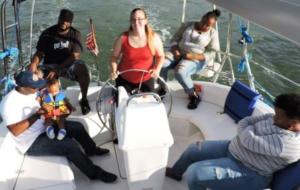HARD TO LEARN—This is a hardy chestnut promoted by motorboat dudes, for whom heavy lifting comprises a case of beer. In fact, sailing is easy to learn because the principals are fairly straightforward. Once you realize how the wind affects the sail, it seems quite logical. There is a certain intellectual challenge to sailing, but it makes it that more invigorating. One- or two-day classes are taught everywhere, most prominently by the American Sailing Association. (Watch video above.)
 EXPENSIVE—Compared to what? Compared to motor-boating, sailing is quite cheap because the fuel of wind is virtually free. It can certainly become expensive to buy a big sailboat, but these days the options are numerous for renting, joining a club, or time-sharing. One can sail quite nicely on a mid-size boat without having to trick it out with pricey electronic gadgets. Keep it simple.
EXPENSIVE—Compared to what? Compared to motor-boating, sailing is quite cheap because the fuel of wind is virtually free. It can certainly become expensive to buy a big sailboat, but these days the options are numerous for renting, joining a club, or time-sharing. One can sail quite nicely on a mid-size boat without having to trick it out with pricey electronic gadgets. Keep it simple.
LABORIOUS—Labor-intensive, perhaps, but happily so. There is a certain level of physical work associated with sailing: raising the sails, adjusting them, tacking the boat, adjusting various controls. None of these is particularly difficult, and they can be learned in an afternoon.
TIME-CONSUMING—It used to take an hour or more to set up the boat to go sailing. But modern boats by the Big Three manufacturers Hunter, Catalina and Beneteau have made it possible to get underway in ten minutes. New technology and reliable systems make sailing quite efficient. The other time-killer is the trip to the boat. If you live 50 miles away, simply move closer. You’ll live longer.
 DOCKING—Nothing strikes the fear of God in a skipper like docking, exacerbated by his wife’s screaming. Well look, you’re not expected to sail the boat into the dock, or the slip. It’s why they come with engines. One expects a certain amount of knocking about, that’s why they have fenders. Just take it easy. A rule of thumb: Proceed into the slip only as fast as you’re willing to bump the boat into the dock if braking doesn’t work well. The American Sailing Association has a one-day course in docking for sailors. Or you can join another boat as crew for the expressed lesson in docking. Videos help too. Eventually you’ll find that stern-to is the preferred docking position because it’s a to easier to get on and off the boat that way. Once you master backing into a slip you’ll be a mariner hero, trust me.
DOCKING—Nothing strikes the fear of God in a skipper like docking, exacerbated by his wife’s screaming. Well look, you’re not expected to sail the boat into the dock, or the slip. It’s why they come with engines. One expects a certain amount of knocking about, that’s why they have fenders. Just take it easy. A rule of thumb: Proceed into the slip only as fast as you’re willing to bump the boat into the dock if braking doesn’t work well. The American Sailing Association has a one-day course in docking for sailors. Or you can join another boat as crew for the expressed lesson in docking. Videos help too. Eventually you’ll find that stern-to is the preferred docking position because it’s a to easier to get on and off the boat that way. Once you master backing into a slip you’ll be a mariner hero, trust me.
DANGEROUS—To be sure, falling off a boat is dangerous. But with careful instruction, one learns to handle the heeling of the boat to maintain balance and stability. The other distinctive danger on a sailboat is the boom, but the Big Three have re-engineered their rigs to fly the booms to swing past anyone as tall as 6-feet-3. The other danger fear is weather. Say it’s raining, hard. Can the boat take it? Can the skipper take it? Then you’ll be fine. Feel free to go below to get out of the storm. As for lightening, it’s true that a sailboat mast is a potential target out on the water, but lightening rarely strikes. I’ve never seen it on the York River or Chesapeake Bay in my 30 years at sea.
Let’s Go Sail
Check rates and pick a day for a sailboat charter. See reviews on Trip Advisor.
Correcting 6 Myths About Sailing Correcting 6 Myths About Sailing Correcting 6 Myths About Sailing



